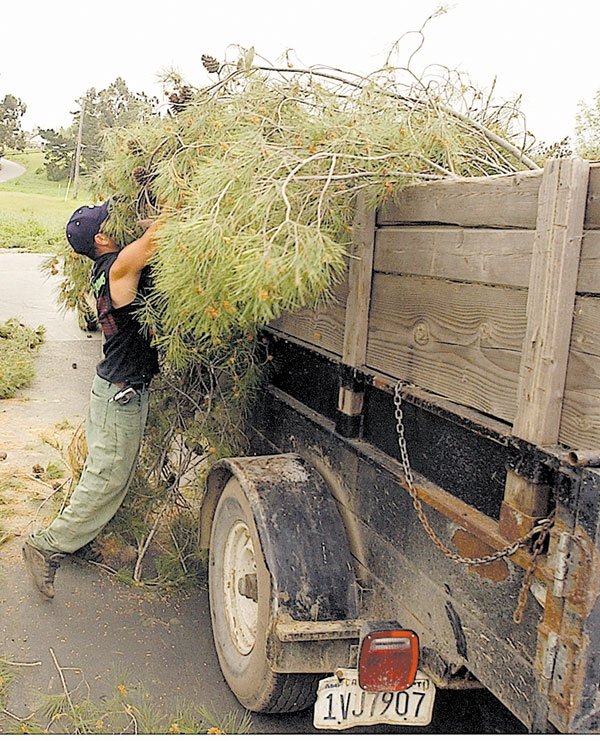A lush green lawn without a dandelion, brown patch or errant
sprinkler head in sight is something akin to the suburbanite’s
grail.
A lush green lawn without a dandelion, brown patch or errant sprinkler head in sight is something akin to the suburbanite’s grail.
But homeowners have to strike a balance between doable and dreamable – somewhere between the idyll of a Lowe’s commercial and the unsightly gristle of an overgrown dirt lot.
Basic know-how can be a handy accompaniment to the hard work a perfect lawn requires, especially if your back yard is less “Better Homes and Gardens” than you would like.
The first step to rehabbing an empty space is to know the soil.
“There’s horrible clay soil in this area, so you need to break up that clay,” said Janet Snodderly, manager of Hollister Landscape Supply, Inc. in Hollister. “We actually recommend if you’re going to do that that you follow it up with straight organic compost onto the area, two to three inches deep, and then Rototill it to a depth of two to four inches.”
Next, homeowners will have to make a choice in grasses based on any number of factors from price to durability, taking into account both their most comfortable timetable and the design of their lawn.
Sod offers nearly instant results if owners are looking to improve curb appeal, but it is the more expensive choice in terms of lawn makeovers.
More budget-conscious homeowners may want to choose grass seed, said Dale Haluza, a customer service dispatcher at the Grass Farm in Morgan Hill.
Both grass options establish themselves in local soil over time, but sod gets comfortable first, generally settling in after about three weeks, versus the six to eight months grass seed requires to establish itself.
In that time period, the seed could fall victim to weeds or “sparse termination,” when little patches of lawn die, said Haluza, but by the end of the establishment period, hardy local grasses will be firmly entrenched with root systems as deep as two feet.
“The fescues are the most drought tolerant and that’s what we grow,” said Haluza. “They’re used in athletic fields, so with proper maintenance they’ll last you 10 years. And they’re cool weather grasses, so they stay green all year.”
For those who desire the instant gratification that comes with sod, prepare to water.
The turf needs full sunlight and a healthy drink three times a day for the first 10 to 14 days after installation, but carefully plot this watering schedule, as you’ll need to mow the lawn after one week.
Moreover, homeowners will need to consider the type of lawn they would like to see. Most cut the grass as short as possible, hoping to go just one more week between cuttings, but the length of the grass contributes to the turf’s overall health, protecting the grass’ root system by shading the ground below and helping to keep moisture locked into the soil, said Snodderly.
“You never want to cut below an inch and a half,” Snodderly said. “It should be mowed at a height between one and a half and two inches, two and a half in the summer.”
The lawn should also be aerated and fertilized twice a year for the first three years, said Snodderly.
Rentable aerating machines pull up small shoots of grass, leaving openings for fertilizer to penetrate deeper into the soil and thus readjusting the nutrient levels in an area.
However, homeowners must be mindful of timing, and experts recommend this process take place in the early spring and late fall, when weather is neither too warm nor too cold for the task.
Fertilizing a lawn requires little more than patience and a somewhat green thumb since once the fertilizer is spread, homeowners must water it into the ground.
“Most of the time, when there are problems, it’s either overwatered or underwatered,” said Snodderly. “If they fertilized when it was too hot, it’s probably burned. Fertilizer is a great product, but it’s what they call hot. It produces heat when it decomposes, and so if you spread it, and you don’t water it down really well, it will burn the lawn, and it will actually turn the lawn brown.”
The results, it turns out, are something akin to a bad perm. It has to grow out completely before you can say it’s gone.
But never fear. If the idea of home yard care is just too daunting, or family members don’t have time in their busy schedules, a gaggle of gardeners are waiting just a phone call away.
“We’re in a yard for anywhere from a half hour to an hour once a week, but it depends on the size of your yard,” said Todd Baker, owner of the Big Red Yard Service in Hollister. “The biggest mistakes we see are when people are fertilizing their own lawns or trying to get rid of weeds. Some buy Round-up at Home Depot and think, ‘Oh! I’m just spraying the weeds in my lawn.’ They don’t realize they’re spraying their lawn, too.”
Baker and his crew come prepared to tackle everything from leaking sprinkler systems to fence-high weeds for around $65 to $100 per month, a price that more and more families are finding enticing.
“When I first started the business in ’93, it was the elderly who I got calls from,” said Baker. “The market is totally changed now. It’s people who are younger and with kids. They’re commuting and totally don’t have time for their yard.”













